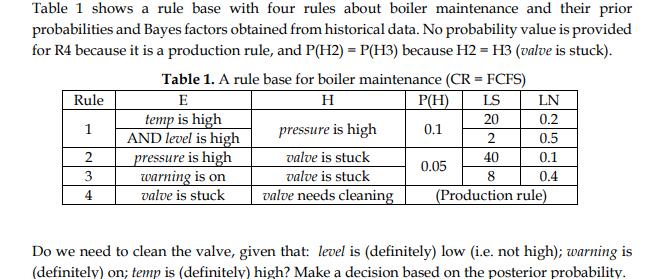Answered step by step
Verified Expert Solution
Question
1 Approved Answer
Table 1 shows a rule base with four rules about boiler maintenance and their prior probabilities and Bayes factors obtained from historical data. No


Table 1 shows a rule base with four rules about boiler maintenance and their prior probabilities and Bayes factors obtained from historical data. No probability value is provided for R4 because it is a production rule, and P(H2) = P(H3) because H2 H3 (valve is stuck). Table 1. A rule base for boiler maintenance (CR = FCFS) Rule E H P(H) LS LN 20 0.2 1 temp is high AND level is high pressure is high 0.1 2 0.5 2 40 0.1 valve is stuck valve is stuck 0.05 pressure is high warning is on valve is stuck 3 8 0.4 4 valve needs cleaning (Production rule) Do we need to clean the valve, given that: level is (definitely) low (i.e. not high); warning is (definitely) on; temp is (definitely) high? Make a decision based on the posterior probability. Table 1 shows a rule base with four rules about boiler maintenance and their prior probabilities and Bayes factors obtained from historical data. No probability value is provided for R4 because it is a production rule, and P(H2) = P(H3) because H2 H3 (valve is stuck). Table 1. A rule base for boiler maintenance (CR = FCFS) Rule H P(H) LS LN E temp is high AND level is high 20 0.2 1 pressure is high 0.1 2 0.5 2 40 0.1 0.05 3 pressure is high warning is on valve is stuck valve is stuck valve is stuck valve needs cleaning 8 0.4 4 (Production rule) Do we need to clean the valve, given that: level is (definitely) low (i.e. not high); warning is (definitely) on; temp is (definitely) high? Make a decision based on the posterior probability.
Step by Step Solution
★★★★★
3.32 Rating (146 Votes )
There are 3 Steps involved in it
Step: 1
Given P H 01 PH 005 P H3 2 P H Posterior Probability repr V P HE Prior PENT S ...
Get Instant Access to Expert-Tailored Solutions
See step-by-step solutions with expert insights and AI powered tools for academic success
Step: 2

Step: 3

Ace Your Homework with AI
Get the answers you need in no time with our AI-driven, step-by-step assistance
Get Started


